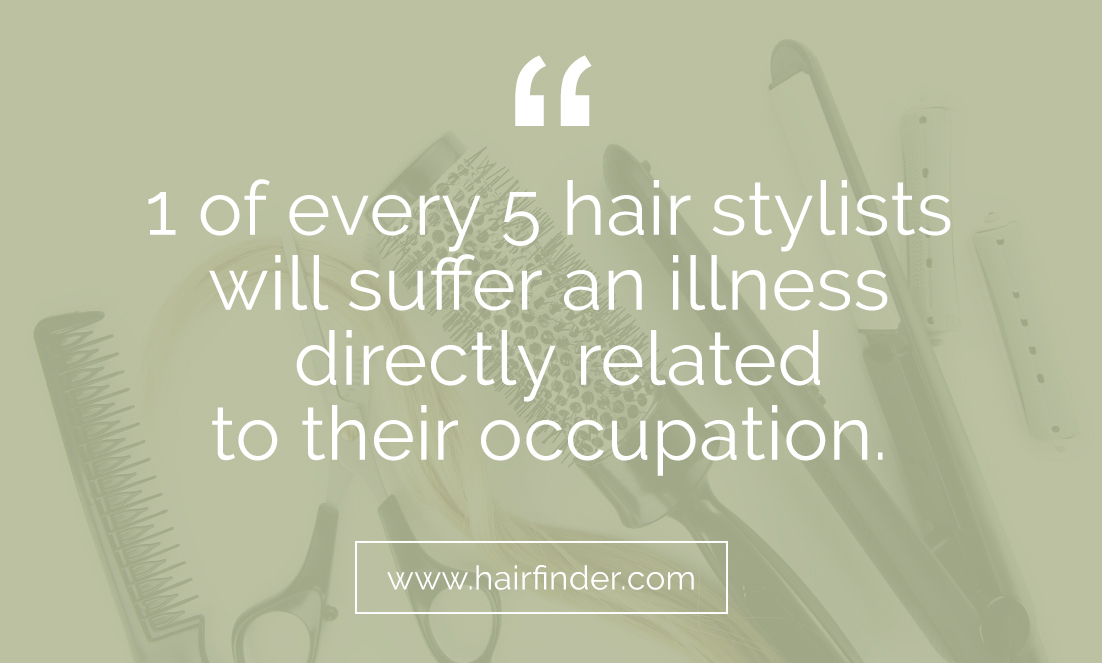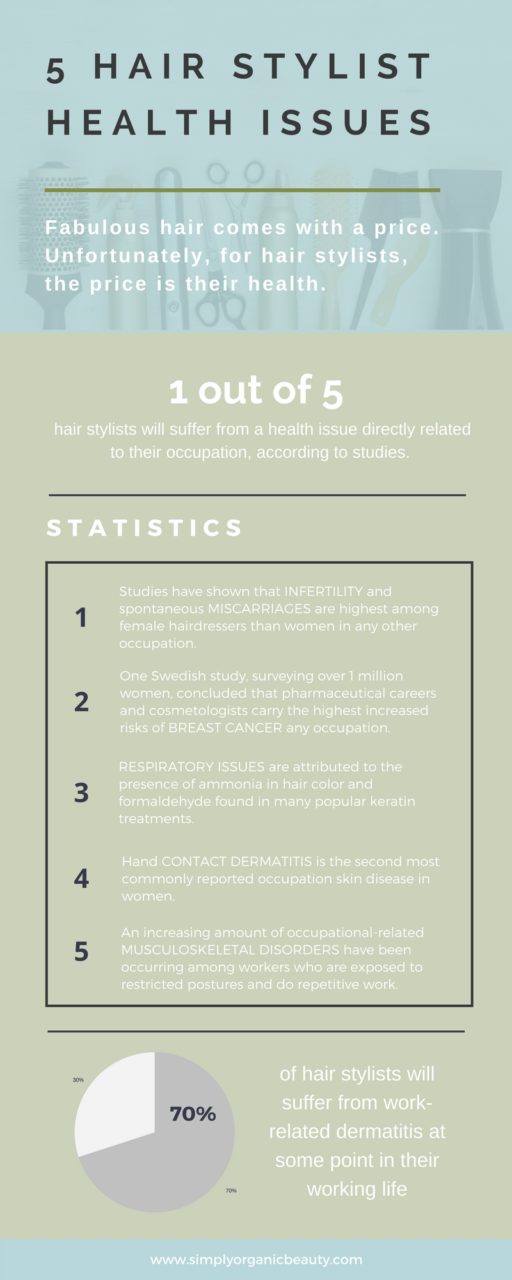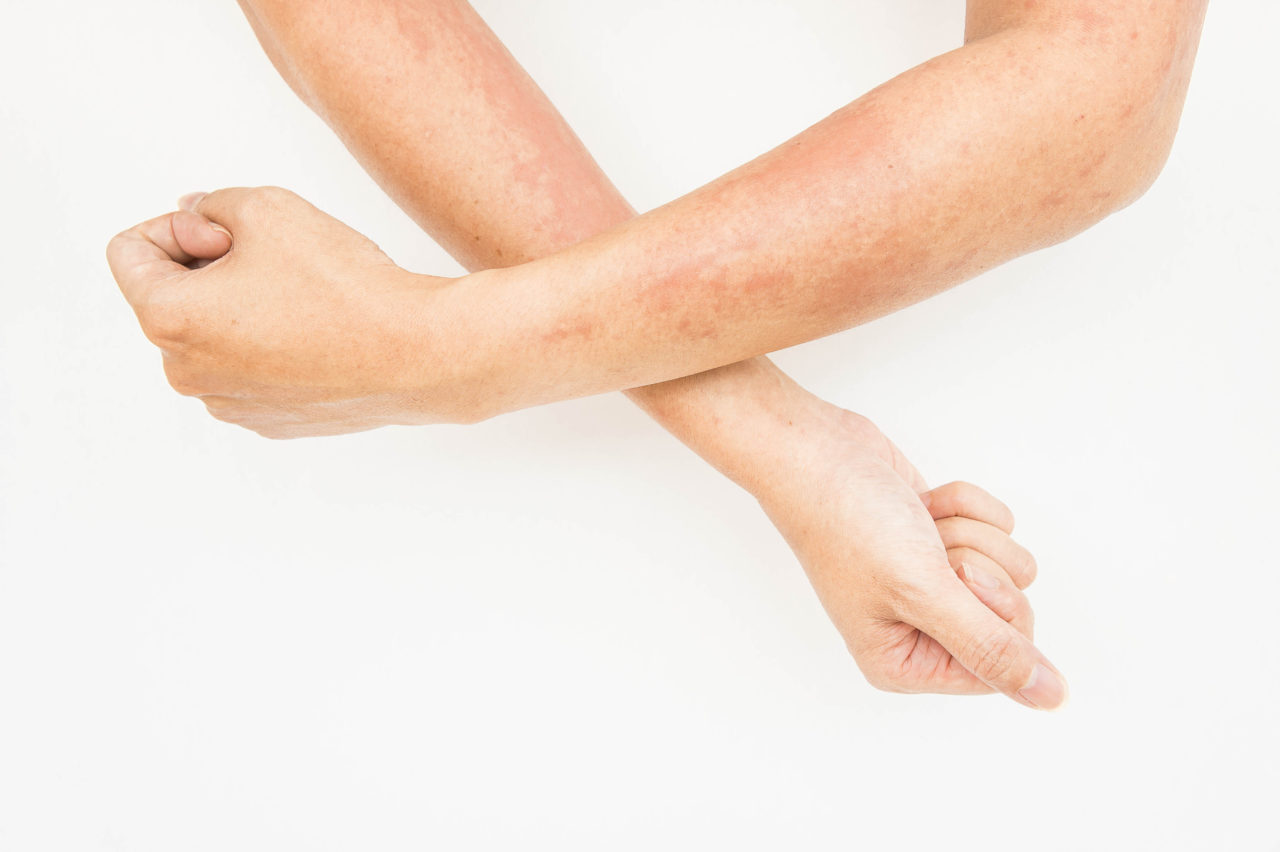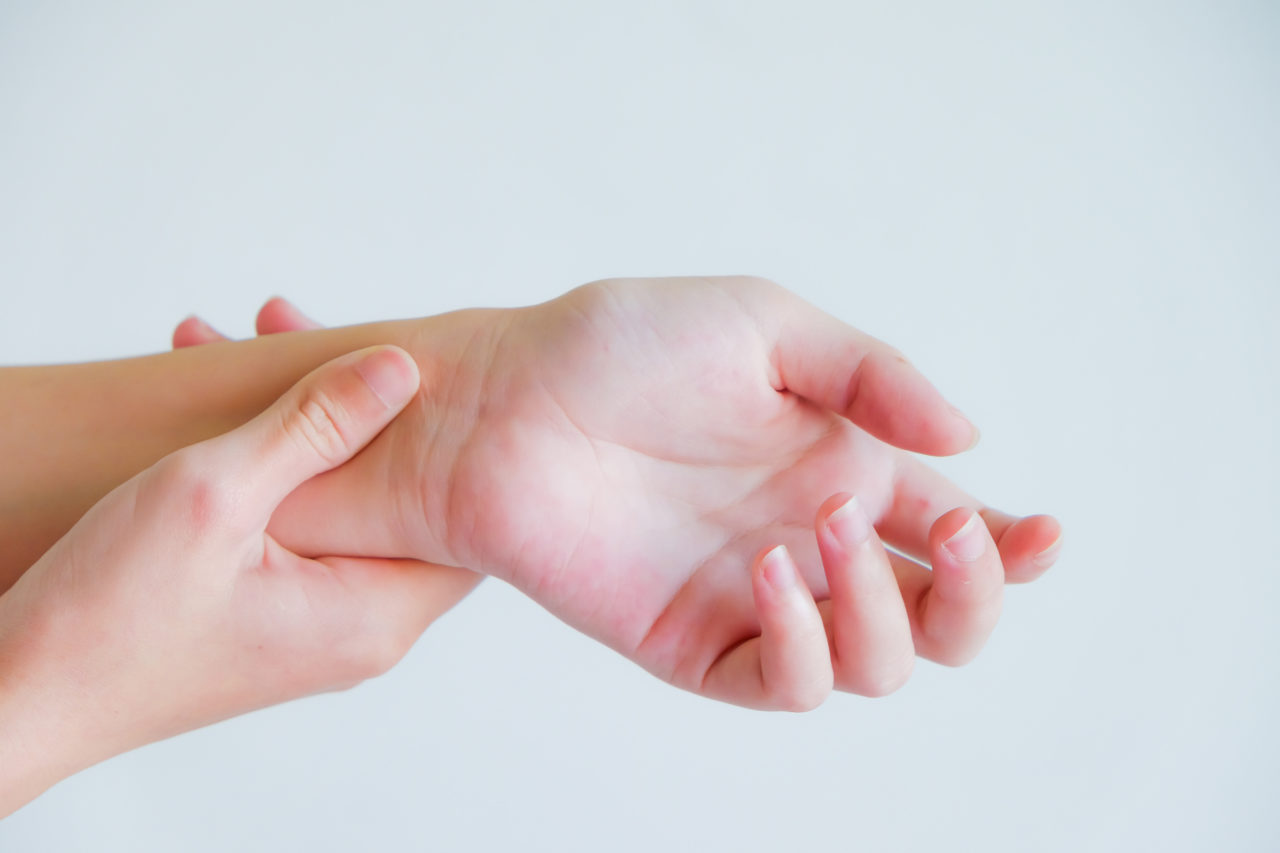Fabulous hair comes with a price, literally and figuratively. Studies suggest 1 of every 5 hair stylists will suffer from a health issue directly related to their occupation [1]. These can come in the form of allergies, breathing problems, and, in some cases, cancer. Below are some of the most common hair stylist health issues and a few suggestions on how to prevent them.
1. Infertility and Pregnancy Complications in Hair Stylists
 Studies have shown that infertility and spontaneous miscarriages are highest among female hairdressers than women in any other occupation [1].
Studies have shown that infertility and spontaneous miscarriages are highest among female hairdressers than women in any other occupation [1].
Everyday, hair stylists are exposed to chemical agents found in hair dyes, keratin treatments, perms, and other in-salon services. While exposure to these chemicals in small amounts may prove innocuous, hair stylist health issues can be directly attributed to the compounding effects of consistent chemical exposure [1].
How does this relate to hair stylists who wish to conceive? The chemicals found in common salon products are suspected to have adverse effects on the hypothalamic-pituitary-ovarian axis.
Meaning, the pituitary gland (attached to the hypothalamus area of the brain) and a woman’s reproductive organs work in synchronicity to balance hormone levels, and any interruption of this delicate cycle can pose significant issues for pregnant women or those trying to conceive.
Another epidemiologic study focused on hairdressers found associations with menstrual disorders and higher rates of unprecedented miscarriages among hair stylists. Significant associations were found for irregular cycles, oligomenorrhoea, long blood loss, heavy pains and long pains after confounding correction. [2]

2. Breast Cancer and Cancer Risks of Hair Stylists
One Swedish study, surveying over 1 million women, concluded that pharmaceutical careers and cosmetologists carry the highest increased risks of breast cancer of any occupation [3].
The American Journal of Epidemiology concluded that hair stylists had triple the risk of developing breast cancer when they worked with hair dye for over 5 years.
Studies showed a direct link to potential breast cancer for hairstylists that used hair dyes on their clients; however, it did not show a significant link for actual salon clients.
Regular exposure to hair dyes, processing agents, and other chemicals used in hair salons and barbershops probably increases cancer risk, according to the International Agency for Research on Cancer (IARC), a World Health Organization panel that maintains the world’s most commonly used system for classifying carcinogens, and is the utmost authoritative source on cancer-causing ingredients.
Unfortunately, breast cancer is not the only cancer that has been proven to appear more in hair stylists. Studies show statistically significant associations between permanent hair dye use and bladder cancer risks; specifically, male hair stylists and barbers have been found to be more likely to have bladder cancer [4].
Scientists attribute some of these hair stylist health issues to aromatic amines in hair color [5].
What is an aromatic amine?
Aromatic amines are derivatives of ammonia with an aromatic substitute, usually containing one or more benzene rings. These health pollutants can be found in tobacco smoke, pharmaceuticals, pesticides, and environmental pollutants, such as diesel exhaust.
Does your hair color contain any of these common aromatic amines?
- O-toulidine/2-methylaniline (classified carcinogen)
- 2,4-toluenediamine
- resorcinol
- m-phenylenediamine
- p-aminophenol
- m-aminophenol
- p-phenylenediamine
Did you know O-toluidine, has been identified in the breast milk of healthy lactating women? [6].
Although these pigment types can cause issues, they are still very necessary to color hair at the professional level. How can you avoid exposure to these amines? Choose a professional ammonia-free hair color with the least amount of PPDs and other types of pigment.
3. Breathing and Respiratory Complications in Hair stylists
One of the most common health issues of hair stylists is respiratory and breathing issues. These complications are attributed to the presence of ammonia in hair color and formaldehyde found in many popular keratin treatments.
Ammonia is a corrosive substance known to cause health issues, such as irritation of the skin, respiratory tract, lungs, and esophageal passage.
The harmful effects of ammonia in salons have been debated by those in the beauty industry for years. However, we’re beginning to understand that exposure to these chemicals has been linked to upper respiratory diseases, occupational asthma, and in some studies, lung cancer. In France, a study found that even though hairdressers represent about 1% of their entire workforce, 20% of the women affected by work-related asthma are hairdressers.[7]

4. Contact Dermatitis and Allergies Among Hair Stylists
 Hand contact dermatitis is the second most commonly reported occupation skin disease in women [8].
Hand contact dermatitis is the second most commonly reported occupation skin disease in women [8].
Around 7 of every 10 hair stylists will suffer from work-related dermatitis at some point in their working life – and in severe cases, it can mean the end of their career [8].
Contact dermatitis can be caused by frequent exposure to irritating chemicals in hair salon products, bleach, prolonged glove wearing, and use of shampoos and conditioners that are not pH balanced. This is exacerbated by the fact that hair stylists often come in contact with water, which can lead to irritant skin damage and sensitization.
Allergic reactions like contact dermatitis are common among hair stylists due to their repetitive exposure to aqueous products and chemicals.
Allergies are extremely problematic because they can occur after just one use or after multiple uses, and the reactions can be mild to severe. The discomfort can also last anywhere from a few hours to a few weeks.
5. Musculoskeletal Disorders among Hair Stylists
 An increasing amount of occupational-related musculoskeletal disorders have been occurring among workers who are exposed to manual labor, work in unusual positions, restricted postures, and do repetitive work.
An increasing amount of occupational-related musculoskeletal disorders have been occurring among workers who are exposed to manual labor, work in unusual positions, restricted postures, and do repetitive work.
As most hairdressers stand on their feet all day, it may come as no surprise that musculoskeletal disorders are another common health risk for hair stylists. Not to mention, the posture required to cut and color hair is far from ideal.
Aside from upper and lower back pain, hair stylists are prone to developing Carpal Tunnel Syndrome – a painful ailment of the nerves and muscles in the hand – as they are frequently using their hands.
As you can see, hair stylist health issues are on the rise and are needing to be addressed. We hope with increased knowledge and visibility, hair stylists will be better able to take steps to prevent these health issues.
As you can see, hair stylist health issues are on the rise and are needing to be addressed. We hope with increased knowledge and preventable measures, hair stylists will be better able to take steps to prevent these health issues.
How to prevent common health issues in Hairstylists
Unfortunately, due to genetics and other inherited traits, some hair stylists will always be more prone to health issues than others. The best way to prevent this type of complication are the following:
- Avoid hormone disrupting chemicals like parabens and phthalates (found in plastics and synthetic fragrance)
- Ensure you’re getting regular annual check ups at your OBGYN and general doctor
- If you suspect hormone disruption or issues, consider speaking with your doctor about ordering a blood test immediately
- Drink adequate amounts of water thorough the day to stay hydrated
- Try moderate exercise like yoga and targeted stretching techniques on pain points like the hands, hips and feet
- Practice gratitude and promoting a healthy mind and body
Sources:
[1] Infertility and spontaneous abortion among female hairdressers: the Hordaland Health Study. Baste V, Moen BE, Riise T, Hollund BE, Øyen N. J Occup Environ Med. 2008 Dec; 50(12):1371-7.
[2] Reproductive disorders due to chemical exposure among hairdressers. Kersemaekers WM, Roeleveld N, Zielhuis GA: Scand J Work Environ Health 1995, 21:325-334.
[3] Fertility disorders and pregnancy complications in hairdressers – a systematic review. Peters C., Harling M., Dulon M. Journal of Occupational Medicine and Toxicology 2010, 5:24
[4] Cancer Mortality in Male Hairdressers. Alderson, Michael. Journal of Epidemiology and Community Health, 1980, 34, 182-185
[5] Carcinogenicity of some aromatic amines, organic dyes, and related exposures. Robert Baan, Kurt Straif, Yann Grosse,Beatrice Secretan, Fatiha El Ghissassi, Veronique Bouvard, Lamia Benbrahim-Tallaa, Vincent Cogliano. The Lancet Oncology, Vol 9, April 2008
[6] Perspives on the chemical etiology of breast cancer. DeBruin, L., & Josephy, P. Environ Health Persp, 2002, 110, 119–128.
[7] European Agency for Safety and Health at Work. (2014). Occupational health and safety in the hairdressing sector. Available: https://osha.europa.eu/en/tools-and-publications/publications/literature_reviews/occupational-health-and-safety-in-the-hairdressing-sector
[8] Ford, Susan. Occupational Health – http://dermnetnz.org/reactions/hairdressers.html; 2013.




